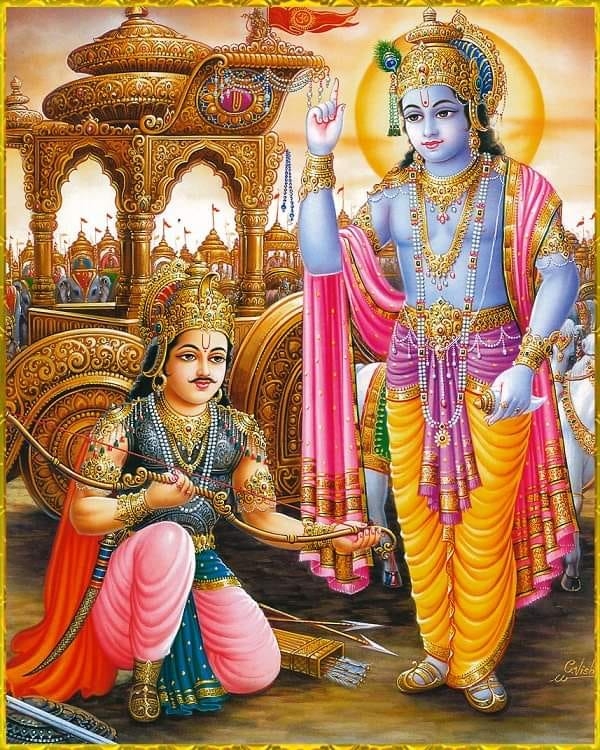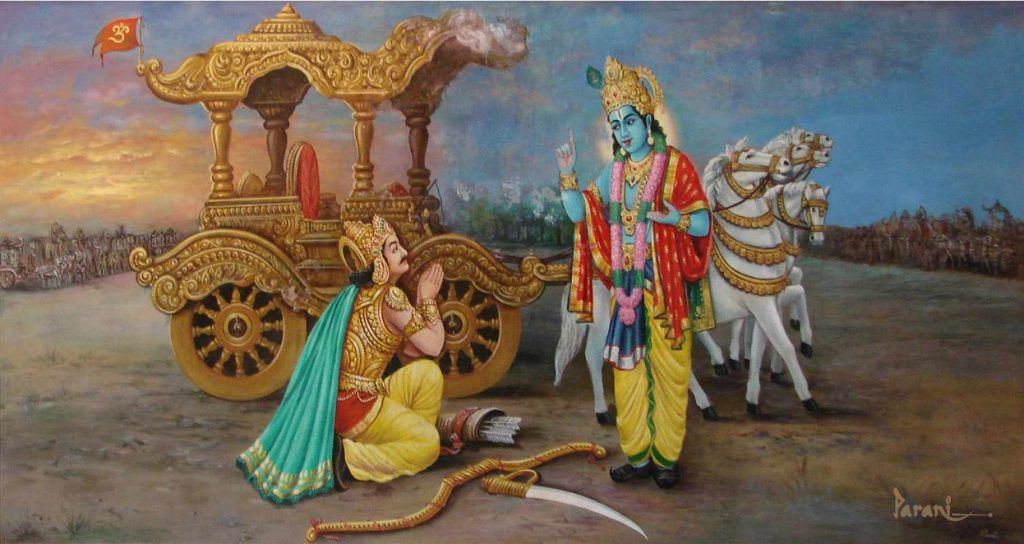The Bhagavad Gita | Chapter 14 : The Three Gunas
अथ चतुर्दशोஉध्यायः ।
श्रीभगवानुवाच ।
परं भूयः प्रवक्ष्यामि ज्ञानानां ज्ञानमुत्तमम् ।
यज्ज्ञात्वा मुनयः सर्वे परां सिद्धिमितो गताः ॥ 1 ॥
इदं ज्ञानमुपाश्रित्य मम साधर्म्यमागताः ।
सर्गेஉपि नोपजायन्ते प्रलये न व्यथन्ति च ॥ 2 ॥
मम योनिर्महद्ब्रह्म तस्मिन्गर्भं दधाम्यहम् ।
सम्भवः सर्वभूतानां ततो भवति भारत ॥ 3 ॥
सर्वयोनिषु कौन्तेय मूर्तयः सम्भवन्ति याः ।
तासां ब्रह्म महद्योनिरहं बीजप्रदः पिता ॥ 4 ॥
सत्त्वं रजस्तम इति गुणाः प्रकृतिसम्भवाः ।
निबध्नन्ति महाबाहो देहे देहिनमव्ययम् ॥ 5 ॥
तत्र सत्त्वं निर्मलत्वात्प्रकाशकमनामयम् ।
सुखसङ्गेन बध्नाति ज्ञानसङ्गेन चानघ ॥ 6 ॥
रजो रागात्मकं विद्धि तृष्णासङ्गसमुद्भवम् ।
तन्निबध्नाति कौन्तेय कर्मसङ्गेन देहिनम् ॥ 7 ॥
तमस्त्वज्ञानजं विद्धि मोहनं सर्वदेहिनाम् ।
प्रमादालस्यनिद्राभिस्तन्निबध्नाति भारत ॥ 8 ॥
सत्त्वं सुखे सञ्जयति रजः कर्मणि भारत ।
ज्ञानमावृत्य तु तमः प्रमादे सञ्जयत्युत ॥ 9 ॥
रजस्तमश्चाभिभूय सत्त्वं भवति भारत ।
रजः सत्त्वं तमश्चैव तमः सत्त्वं रजस्तथा ॥ 10 ॥
सर्वद्वारेषु देहेஉस्मिन्प्रकाश उपजायते ।
ज्ञानं यदा तदा विद्याद्विवृद्धं सत्त्वमित्युत ॥ 11 ॥
लोभः प्रवृत्तिरारम्भः कर्मणामशमः स्पृहा ।
रजस्येतानि जायन्ते विवृद्धे भरतर्षभ ॥ 12 ॥
अप्रकाशोஉप्रवृत्तिश्च प्रमादो मोह एव च ।
तमस्येतानि जायन्ते विवृद्धे कुरुनन्दन ॥ 13 ॥
यदा सत्त्वे प्रवृद्धे तु प्रलयं याति देहभृत् ।
तदोत्तमविदां लोकानमलान्प्रतिपद्यते ॥ 14 ॥
रजसि प्रलयं गत्वा कर्मसङ्गिषु जायते ।
तथा प्रलीनस्तमसि मूढयोनिषु जायते ॥ 15 ॥
कर्मणः सुकृतस्याहुः सात्त्विकं निर्मलं फलम् ।
रजसस्तु फलं दुःखमज्ञानं तमसः फलम् ॥ 16 ॥
सत्त्वात्सञ्जायते ज्ञानं रजसो लोभ एव च ।
प्रमादमोहौ तमसो भवतोஉज्ञानमेव च ॥ 17 ॥
ऊर्ध्वं गच्छन्ति सत्त्वस्था मध्ये तिष्ठन्ति राजसाः ।
जघन्यगुणवृत्तिस्था अधो गच्छन्ति तामसाः ॥ 18 ॥
नान्यं गुणेभ्यः कर्तारं यदा द्रष्टानुपश्यति ।
गुणेभ्यश्च परं वेत्ति मद्भावं सोஉधिगच्छति ॥ 19 ॥
गुणानेतानतीत्य त्रीन्देही देहसमुद्भवान् ।
जन्ममृत्युजरादुःखैर्विमुक्तोஉमृतमश्नुते ॥ 20 ॥
अर्जुन उवाच ।
कैर्लिङ्गैस्त्रीन्गुणानेतानतीतो भवति प्रभो ।
किमाचारः कथं चैतांस्त्रीन्गुणानतिवर्तते ॥ 21 ॥
श्रीभगवानुवाच ।
प्रकाशं च प्रवृत्तिं च मोहमेव च पाण्डव ।
त द्वेष्टि सम्प्रवृत्तानि न निवृत्तानि काङ्क्षति ॥ 22 ॥
उदासीनवदासीनो गुणैर्यो न विचाल्यते ।
गुणा वर्तन्त इत्येव योஉवतिष्ठति नेङ्गते ॥ 23 ॥
समदुःखसुखः स्वस्थः समलोष्टाश्मकाञ्चनः ।
तुल्यप्रियाप्रियो धीरस्तुल्यनिन्दात्मसंस्तुतिः ॥ 24 ॥
मानापमानयोस्तुल्यस्तुल्यो मित्रारिपक्षयोः ।
सर्वारम्भपरित्यागी गुणातीतः स उच्यते ॥ 25 ॥
मां च योஉव्यभिचारेण भक्तियोगेन सेवते ।
स गुणान्समतीत्यैतान्ब्रह्मभूयाय कल्पते ॥ 26 ॥
ब्रह्मणो हि प्रतिष्ठाहममृतस्याव्ययस्य च ।
शाश्वतस्य च धर्मस्य सुखस्यैकान्तिकस्य च ॥ 27 ॥
ॐ तत्सदिति श्रीमद्भगवद्गीतासूपनिषत्सु ब्रह्मविद्यायां योगशास्त्रे श्रीकृष्णार्जुनसंवादे
गुणत्रयविभागयोगो नाम चतुर्दशोஉध्यायः ॥14 ॥
Summary
Krishna instructs Arjuna about the ultimate knowledge yoga masters have achieved. He explains he is "the seed-giving father" and that nature is "the womb." All beings come forth from the combination of the two. The three gunas—sattva, rajas, and tamas—are based upon a person's disposition. The gunas keep the eternal Self bound to the physical body. Sattva binds by attachment to knowledge and joy, rajas by passion and activity, and tamas by laziness and sleep. Of the three, sattva has the power to uplift a person and lead to enlightenment because it is connected to wisdom. The other two create stasis, or drag a person down. The guna that rules people when they die is significant because it will dictate the type of rebirth they enter. Arjuna asks Krishna how to recognize someone who has transcended the gunas. Krishna tells Arjuna that the person who has gone beyond the three gunas is unattached and responds equally to sorrow or joy. Such a devotee treats all equally, is "indifferent / to honor and to disgrace," and is "serene in success or failure."
Analysis
Krishna's part of the dialogue reaffirms the qualities of a person who has found enlightenment and comes to understand the true nature of the Self. Krishna gives more detail about the nature of the three gunas. Attachment to any one of the gunas will hold a person back, keeping them in the cycle of death and rebirth. However, the gunas of rajas and tamas are particularly detrimental to a person's process of enlightenment. Although sattva seems desirable, when it is held as an attachment it can keep one bound. For example, overattachment to the pursuit of knowledge or joy can keep a person embodied. Conversely, sattva without attachment can help a person leave the cycle of death and rebirth. Krishna names sattva as the "ruling trait" of a person who is on the path of understanding and knowledge. The "light of knowledge shines forth / through all the gates of the body" in these people. This is one way such a person can be recognized and set apart from those still ruled primarily by rajas or tamas.
Many things can affect the rebirth of a person. The ruling guna at the time of death will determine the situation a person will experience when reborn into the next life. Those who die while ruled by rajas are born to people who are attached to action, whereas those who die while ruled by tamas are born to people who are deluded. This distinction could imply that a person who has led a good life could be reborn into a poor incarnation if they die in a state of anger. Although a person is ruled primarily by one guna or another, it is possible for that person to move back and forth between secondary gunas over the course of a lifetime.
application part in human affairs
In the tapestry of daily life, the teachings from Chapter 14 of the Bhagavad Gita weave a profound narrative, guiding individuals towards self-awareness and balanced living. The recognition of the three gunas—sattva, rajas, and tamas—serves as a compass for mindful decision-making. Understanding one's predominant influence allows for a conscious striving towards equilibrium, fostering a balanced approach to actions. The call for detachment from outcomes echoes in the corridors of resilience, encouraging individuals to focus on the sincerity of effort rather than fixating on success or failure. Pursuit of knowledge is tempered with humility, emphasizing a continuous journey rather than a static destination. Equally crucial is the lesson of maintaining equanimity in the face of joy and sorrow, nurturing emotional resilience in the ebb and flow of life. The teaching extends to breaking the cycle of negative habits, urging individuals to transcend the influences of rajas and tamas, fostering personal transformation. Compassion and equality become guiding stars, prompting the practice of treating all with indifference to honor and disgrace, transcending superficial distinctions. In integrating these timeless principles, individuals embark on a journey of personal growth, mental well-being, and a deeper understanding of their actions, echoing the wisdom of the Bhagavad Gita in the tapestry of their daily existence.



Comments
Post a Comment